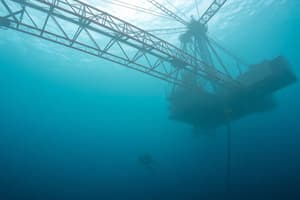Podcast
Questions and Answers
What primary factor contributed to the crane hook striking the diver's helmet during the subsea spool tie-in operations?
What primary factor contributed to the crane hook striking the diver's helmet during the subsea spool tie-in operations?
- Failure to conduct a pre-operation inspection of the diving helmet for structural integrity.
- The diver's failure to maintain a safe distance from the pipe handling frame (PHF).
- The insufficient length of the crane pennant/stinger paired with poor visibility, leading to misjudgment of hook position. (correct)
- Inadequate communication between the diver and the diving supervisor regarding the rigging status.
Which of the following actions would be MOST effective in preventing a recurrence of the incident described?
Which of the following actions would be MOST effective in preventing a recurrence of the incident described?
- Implementing a buddy system to ensure divers are always monitored by a colleague.
- Mandating the use of more durable helmet materials to withstand potential impacts.
- Improving underwater visibility through enhanced lighting systems and decreasing operation time.
- Specifying minimum pennant lengths in project procedures and employing enhanced visibility aids for crane hook positioning. (correct)
Why did the crane operator incorrectly assume the hook had reached the seabed?
Why did the crane operator incorrectly assume the hook had reached the seabed?
- The diving supervisor provided incorrect depth readings.
- The crane operator was not properly trained to interpret weight readings.
- The crane hook came to rest on the top beam of the PHF, resulting in a 'no weight' reading. (correct)
- The diver intentionally created slack in the crane wire, falsely indicating the hook's position.
In the context of subsea operations, why is 'challenging assumptions' considered an important lesson learned?
In the context of subsea operations, why is 'challenging assumptions' considered an important lesson learned?
Besides those mentioned in the "what went wrong" and "what was the cause" sections, which additional measure could enhance safety during subsea lifting operations with limited visibility?
Besides those mentioned in the "what went wrong" and "what was the cause" sections, which additional measure could enhance safety during subsea lifting operations with limited visibility?
Flashcards
Subsea Crane Hook Incident
Subsea Crane Hook Incident
During subsea spool tie-in, a crane hook struck a diver's helmet due to the crane operator assuming the hook was on the seabed. The hook slipped off the PHF beam and hit the diver.
Inadequate Crane Pennant Length
Inadequate Crane Pennant Length
An insufficient length of crane pennant/stinger can create a dangerous situation by reducing the safe distance between divers and the crane hook during subsea operations.
Enhanced Visibility in Subsea Operations
Enhanced Visibility in Subsea Operations
In conditions of poor underwater visibility, it is important to use additional locating beacons, underwater cameras, or sonar. The use of such equipment offers more accurate tracking of critical equipment.
Critical Communication in Diving
Critical Communication in Diving
Signup and view all the flashcards
Pre-Operation Equipment Inspection
Pre-Operation Equipment Inspection
Signup and view all the flashcards
Study Notes
- During subsea spool tie-in operations, a crane hook unexpectedly struck a diver's helmet.
- This safety flash was published on March 6, 2025, and generated on the same day as IMCA SF 04/25.
Incident Details
- Divers were working on the seabed in poor visibility during subsea spool tie-in operations.
- After landing the pipe handling frame (PHF) on the seabed, the Diving Supervisor told the crane operator to lower the crane hook to the seabed.
- This was to allow the diver to disconnect rigging from the crane.
- The crane operator reported no weight on the crane wire.
- The Diving Supervisor assumed the hook had reached the seabed and instructed the diver to proceed with disconnecting the PHF.
- The crane hook unexpectedly struck the diver's helmet while the diver was positioned beneath the PHF and moving to disconnect the rigging.
- The diver reported no injuries and returned to the dive bell.
- The dive was stopped.
- Inspection revealed the diver's reclaim helmet was damaged beyond repair
- The helmet's integrity was maintained along with it's durability
- The diver was unharmed
Positive Actions
- Diver 2 assisted Diver 1, preventing injuries.
- The divers returned to the bell safely.
- Locating beacons on the divers and the crane block enabled accurate tracking.
- Procedures, lifting plans, and Job Hazard Analyses (JHAs) were followed.
- Protective equipment absorbed the impact, preventing injury.
Factors that went wrong
- The crane hook came to rest on the PHF's top beam when lowered for disconnection.
- This resulted in a 'no weight' reading, leading the crane operator to believe the hook had reached the seabed.
- The hook slipped off the beam and hit the diver's helmet as the diver approached the disconnection point.
Root Causes
- Insufficient crane pennant/stinger length, which did not provide adequate distance between the divers and the crane hook.
- Poor visibility hindered the ability to accurately observe the crane hook's position.
Recommended Actions
- Maintain safe clearance between divers and crane hook by ensuring adequate crane pennant/stinger length to reduce accidental contact risk.
- Use alternative methods such as additional locating beacons, underwater cameras, or sonar in low-visibility environments to better track critical equipment like the crane hook.
- Improved monitoring can help prevent errors in location estimation.
- Minimize assumptions regarding equipment position.
- Improve communication and confirmation procedures between the dive supervisor, crane operator, and divers.
- Ensure all parties are aware of the equipment's location.
- Update project procedures to specify minimum pennant lengths for different operations.
- Conduct pre-operation inspections of rigging and lifting equipment, including crane hooks and pennants, to ensure they meet safety standards and are appropriate for the operation.
- Update the Job Hazard Analysis (JHA) to incorporate lessons learned regarding safe distances, visibility, and subsea lifting operations.
Studying That Suits You
Use AI to generate personalized quizzes and flashcards to suit your learning preferences.




